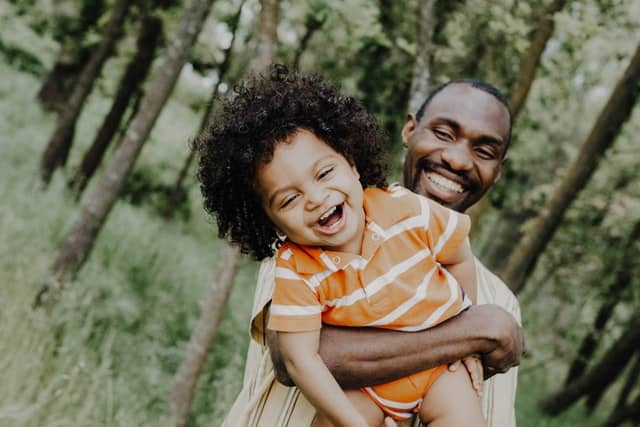Every generation in recent history has grown up in a world where national and international news makes its way into the safety of our living rooms and around our dinner tables.
Though parents, teachers, and other caretakers might try to shield their children from scary sounds, images, and stories, the truth is that kids continue to be exposed to the dangers and stressors in our current culture.
In the 1970s, newsreels squawked out threatening projections about the United States energy crisis.
In the 1980s, the tension between the United States and the Soviet Union threatened war and the AIDS epidemic struck fear and panic.
Then in the 1990s, images of the Los Angeles riots, the Bosnian War, and the Oklahoma City Bombing repeatedly played for months on end.
As we are well aware today, the 2020s have introduced stressors no one could have predicted, and they are affecting our children daily. Masked children are familiar with the pandemic that continues to disrupt their classrooms, though they might not fully grasp the enormity of the threat. Some are aware that friends and loved ones have gotten sick, while others live in households that have been stricken with joblessness and even homelessness.
As caretakers, it behooves us to understand how we can identify the signs of stress and anxiety in children and become familiar with tools we can implement to help them thrive despite anxiety-inducing realities.
Identifying Stress in Children

Anxiety is a natural part of life. It doesn’t always signal a more significant problem–sometimes, it is simply a human reaction to a human dilemma.
For example, if your child sees one classmate teasing another, she may grow anxious. This anxiety could be an empathetic response, during which your child puts his/herself in the other person’s shoes and feels what she might feel if she was being teased. A child’s anxiety in this situation could also be triggered by the fear that the offending classmate may tease him/her one day.
Though these feelings are not comfortable, they are normal and even helpful. Just as some discomfort helps lead adults to pursue healthy, strong responses, they also help children navigate difficult moments.
Some fears are common among specific age groups. Some of these common fears include:
- Strangers
- Loud noises
- Monsters
- The dark
- Bugs
- Sickness
- Dogs
Children experiencing fears can exhibit behaviors resulting from their uncomfortable feelings even if real danger is not present. When worries go unaddressed and unprocessed, they can become stress and anxiety.
Stress in children can manifest in various ways. According to Aetna, these are among the most common:
- Avoidance of specific activities, situations, or people
- A tendency to worry about what can go wrong in any scenario
- Worries or fears that interfere with normal daily activities
- Persistent distress despite an adult’s reassurances
- Trouble sleeping at night or insisting on sleeping with family members
- Physical symptoms, such as headaches or stomach pain that don’t stem from other medical conditions
When you identify these signs of anxiety in your student or child, use the moment to connect with them. You can seek to understand what is at the foundation of their concern and help them clearly articulate the source.
How to Help a Child With Stress and Anxiety

Help your child talk about what is frightening them by asking specific questions.
Often, articulating their fear or frustration can release tension in and of itself. For example, if a child becomes upset at the suggestion of beginning his or her school day on Zoom, you can ask them, “What makes Zoom scary?” Or, “What was difficult about the last time you met your class on Zoom?” These questions can help guide your child toward specific answers.
Once you’ve taken the time to help your child identify the source of their worry, validate the emotion they’re experiencing.
If a child tells you they’re afraid of the dark, and you’ve asked clarifying questions to pinpoint the specific fear, you can say, “I know a lot of children your age who feel afraid of the dark.” Then begin to help your child create a plan to overcome their fear. You may feel compelled to offer a great deal of sympathy or comfort to the child as you discuss their fear of the dark, but it’s best to identify the fear, validate it, and then move on to creating a plan. Too much sympathy can become a reward that reinforces the fear.
After you’ve initiated a conversation with the child, help them create a plan to overcome their fear.
If a student exhibits significant fear of heights, and you’ve helped them identify the fear and validated the fear, such as “I can see you are really afraid of heights,” you can help them plan a way to overcome it.
“How about today you stand at the top of the slide for a few seconds and imagine yourself having a great time going down the slide. By the end of the week, you can give it a try!” Helping children set these goals and then encouraging them along the way lets them know you see them, hear them, and you are willing to support them through difficult emotions and circumstances.
Social and Emotional Learning Helps Children with Stress
NPR recently discussed the importance of social and emotional learning to overwhelmed children.
The author interviewed Olga Acosta Price, director of the National Center for Health and Health Care in Schools. Price says, “Effective social and emotional learning doesn’t happen ‘only at certain times of the day or with certain people,’ it should be reflected in all school operations and practices. With disruptions from the pandemic so widespread, that kind of approach is needed now more than ever.” At Soul Shoppe, we agree.
The best time to help children understand and interact with their emotions–and the feelings of others–is while they are experiencing them throughout the day.
Children are still experiencing crises daily (NY Times). It is our responsibility as adults and caretakers to help guide our children through these tumultuous times by helping them survive and thrive. We can do that when we give them the social and emotional tools to face the dangers–either imagined or real–and grow the skills they need to identify, manage, and reframe complicated feelings.
Soul Shoppe provides social emotional learning programs for elementary schools, homeschoolers, parents, corporations, and more. View online courses or contact us for more information.
You May Also Like:
Virtual Social Emotional Learning Activities
Teaching Empathy to Kids and Teenagers


